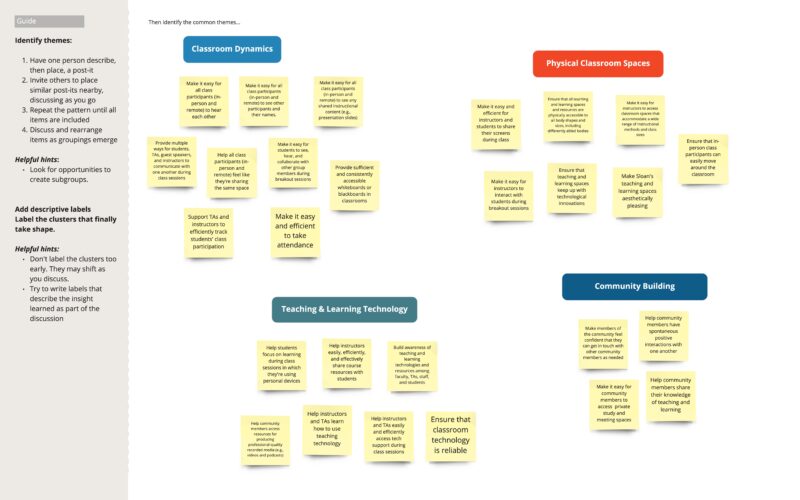In this post in the Classroom of the Future Blog Series, we’ll explore how the team used affinity clustering workshops and prioritization methods to organize research insights into key themes and needs.
During the second step in the Discovery process, we used affinity clustering workshops and research-based prioritization methods to analyze our data. To learn about how we had collected that data, see the previous post in this series: Classroom of the Future Discovery 1: Identifying Needs.
Initial Analysis
First, in summer 2022, we reviewed and synthesized the listening session and classroom observation data. Using patterning and prioritization methods such as the LUMA Institute’s Affinity Clustering and Bull’s Eye Diagramming, we surfaced 27 expressed needs that Sloan could address to better support teaching and learning. You can see all 27 of the expressed needs on p.1 of the Needs Overview document.
Affinity Clustering Workshops
In fall 2022, we drew inspiration from the Voice of the Customer and the LUMA Institute’s Affinity Clustering method and invited faculty, students, and staff to participate in five “affinity clustering” workshops. During those workshops, participants helped us sort the needs into groups. They reviewed the needs on post-its and then rearranged those post-its, “clustering” them into distinct categories.

The data from those workshops enabled us to cluster the needs into a set of four themes:
- Physical Classroom Spaces
- Teaching and Learning Technologies
- Classroom Dynamics
- Community Building
Four Key Themes
Now we’ll take a closer look at the needs through the lens of those themes.
1. Physical Classroom Spaces
The Physical Classroom Spaces theme focuses on in-person classroom environments.
- Classroom availability and resources align with pedagogical needs.
- Spaces are physically accessible to all body shapes and sizes, including differently abled bodies. As a staff member said, “Most of the campus is able bodied, but there are… physical challenges that are not obvious. And we always want to make sure that the teaching environment and all environments on campus are for everyone.”
- Spaces keep up with tech innovations.
- Spaces are comfortable and aesthetically appealing. As a faculty member said, “I love the light, the big windows, like to really be able to decide whether you want it completely dark or not. ”
2. Teaching and Learning Technologies
The Teaching and Learning Technologies theme centers around how digital tools and classroom technology support teaching and learning.
- Classroom technology is reliable. As a faculty members said, “When [the technology] doesn’t work…you lose 15 minutes out of an 80-minute class and you’re in big trouble.”
- It’s easy to access emergency tech support.
- Teaching teams know what technologies Sloan supports and how to use them. As a faculty member said, “These resources—if they exist, we need to know more about them so that we can use them. ”
- Community members can easily access resources to support T&L video/media creation.
3. Classroom Dynamics
The Classroom Dynamics theme focuses on instructors’ and students’ communication and collaboration during class.
- Class participants can easily see and hear each other. As a faculty member said, “Everyone needs to feel and appear as if they are actually in the room—no friction, no diminishment, no lurkers/free riders.”
- Students and instructors can communicate through speech and by typing (backchanneling).
- Class participants can efficiently share ideas through screensharing and board writing. As a faculty member said, “The screen share function [in Zoom] is excellent… how great would it be in the classroom if students could easily share their screen to displays?”
- It’s simple to take attendance and track participation.
4. Community Building
The Community Building theme highlights how interactions with the larger Sloan community affect students’ and faculty members’ teaching and learning experiences.
- There’s a strong sense of community. As a student said, “How can we have more spontaneous positive interactions with people?… There are some parts of Sloan that do this really well. And there are other parts that—I hate to be the bearer of bad news, but we need to figure out a way to do a lot better. ”
- It’s easy to get in touch.
- Faculty have opportunities to share their knowledge of T&L. As a faculty member said, “My favorite resource would be my colleagues. I like to hear what they’re doing—and what people at other schools are doing too. ”
- Community members can access private study/meeting spaces.
Facilitating the affinity clustering workshops and organizing the expressed needs helped us understand the community’s input and begin to form solutions. In the next post, we’ll share how we used a survey to assess the importance of the needs and the school’s current performance in meeting those needs.









